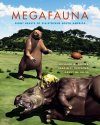By: Richard A Fariña(Author), Sergio F Vizcaíno(Author), Gerry De Iuliis(Author)
436 pages, 11 colour & 237 b/w photos and illustrations
![Megafauna Megafauna]()
Click to have a closer look
About this book
Contents
Customer reviews
Biography
Related titles
About this book
More than 10,000 years ago spectacularly large mammals roamed the pampas and jungles of South America. This book tells the story of these great beasts during and just after the Pleistocene, the geological epoch marked by the great ice ages. Megafauna: The Giant Beasts of Pleistocene South America describes the history and way of life of these animals, their comings and goings, and what befell them at the beginning of the modern era and the arrival of humans. It places these giants within the context of the other mammals then alive, describing their paleobiology – how they walked; how much they weighed; their diets, behavior, biomechanics; and the interactions among them and with their environment.
It also tells the stories of the scientists who contributed to our discovery and knowledge of these transcendent creatures and the environment they inhabited. The episode known as the Great American Biotic Interchange, perhaps the most important of all natural history "experiments," is also an important theme of the book, tracing the biotic events of both North and South America that led to the fauna and the ecosystems discussed in Megafauna: The Giant Beasts of Pleistocene South America.
Contents
Prologue
1. Paleontology and Science: What is Science?
2. Distinguished Paleomammalogists
3. Geologic and Ecological History of South America During the Cenozoic Era
4. North American Late Cenozoic Faunas
5. The Great American Biotic Interchange and Pleistocene Habitats in South America
6. Bestiary
7. Physics of the Giants
8. General Paleoecology
9. Extinction
Appendix 1: A Primer on Skeletal Anatomy
Appendix 2: Skeletal Anatomy of Xenarthrans
Appendix 3: Equations Used to Estimate Body Masses Based on Dental and Skeletal Measurements and Their Respective Sources.
Appendix 4: Calculations
References
Index
Customer Reviews
Biography
Richard A Fariña is Professor of Palaeontology at the Facultad de Ciencias, Universidad de la Republica, Montevideo, Uruguay. He has also published science books for a general readership and collaborated in TV documentaries on the subjects of his expertise.
Sergio F. Vizcaíno is Professor of Vertebrate Zoology at the Universidad Nacional de La Plata and researcher of the Consejo Nacional de Investigaciones Cientificas y Tecnicas working at the Museo de La Plata, Argentina. His research focuses on the paleobiology of South American fossil vertebrates, mostly mammals He has participated in numerous field work seasons in Argentina and Antarctica. He was the President of the Asociacion Paleontologica Argentina.
Gerry De Iuliis is affiliated with the Department of Ecology and Evolutionary Biology at the University of Toronto.
By: Richard A Fariña(Author), Sergio F Vizcaíno(Author), Gerry De Iuliis(Author)
436 pages, 11 colour & 237 b/w photos and illustrations
"These bizarre beasts are wonderful exemplars of parallel evolution, controversial in their implications for competition/extinction [...] and just plain intriguing!"
– Donald Prothero, author of After the Dinosaurs
"The history of the South American megafauna is a fascinating topic. For much of the Cenozoic Era South America was an island continent in which the carnivores were all marsupials and the herbivores were primitive ungulates that evolved into forms functionally similar to unrelated animals found elsewhere in the world. [They] were a unique blend of indigenous and immigrant animals that had apparently reached equilibrium in the wake of the Great American Interchange. When and why many of them subsequently went extinct has yet to be fully resolved [...]"
– John Harris, Chief Curator of the George Page Natural History Museum
"Overall, [this] is an enjoyable read that provides a substantial amount of detail on the biology, ecology, and distribution of these fantastic animals [...] Highly recommended."
– Choice




















































